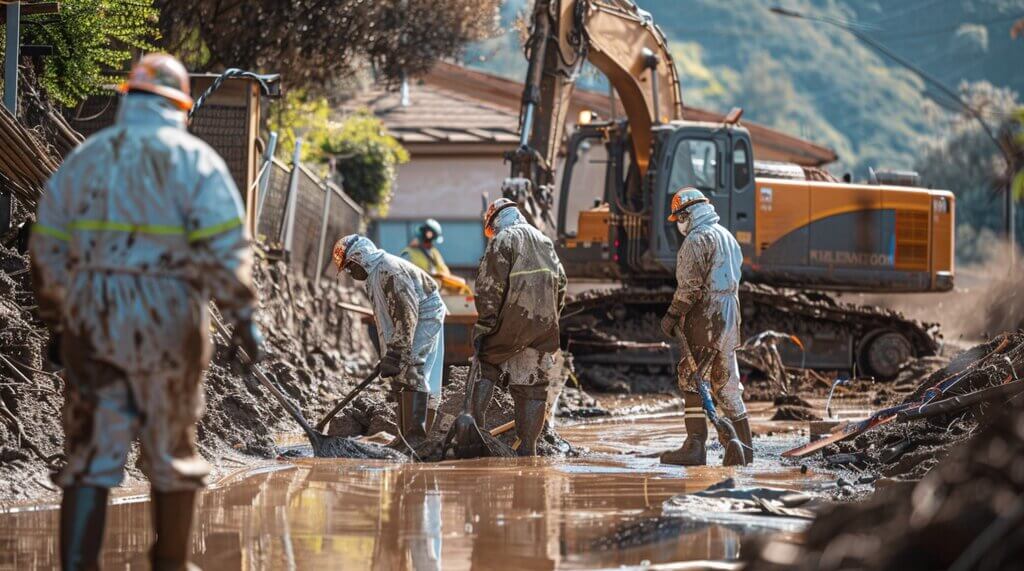In the domain of property restoration and repair, few challenges rival the complexity and urgency demanded by mudslide damage.
The aftermath of a mudslide presents a multitude of intricate issues that necessitate a meticulous approach and specialized knowledge to address effectively.
From evaluating the extent of property damage to implementing safety protocols during restoration, each phase requires a strategic and experienced hand to navigate.
As we explore the intricacies of mudslide damage restoration and repair, a deeper understanding of the process reveals the critical role that expert services such as Deakins Restoration play in restoring stability and security to affected properties.
In the domain of property restoration services, comprehending the complexities of mudslide damage is essential for effectively mitigating and restoring affected areas.
Mudslides can cause extensive destruction to properties, including structural damage, soil erosion, and debris accumulation.
Understanding the specific characteristics of mudslide damage, such as the velocity and volume of mudflow, is vital in devising a thorough restoration plan.
Factors like soil composition, topography, and drainage patterns play a significant role in evaluating the extent of the damage.
Professional expertise in evaluating these elements is key to ensuring a complete restoration process that addresses both visible and underlying issues caused by mudslides.
Understanding the full extent of property damage caused by mudslides requires a meticulous assessment that considers the structural integrity, soil erosion patterns, and debris impact on the affected area.
To effectively assess property damage after a mudslide, follow these key steps:
Upon encountering a mudslide disaster, swift and strategic response actions are imperative to mitigate further damage and guarantee the safety of individuals and property.
Immediate steps should include evaluating the safety of the surroundings, evacuating if necessary, and reaching out to emergency services for assistance.
Here is a table to outline the initial response actions:
| Immediate Response Actions |
|---|
| Evaluate Safety of Surroundings |
| Evacuate if Necessary |
| Reach out to Emergency Services |
| Document Damage and Conditions |
Taking these actions promptly can help prevent additional harm and begin the restoration process efficiently.
Remember, safety is the top priority in any disaster situation.
Implementing meticulous safety precautions during the restoration process is paramount to safeguarding both individuals and property.
To guarantee a safe restoration environment, consider the following:
To secure a thorough restoration process following a mudslide, the initial step involves meticulously cleaning up the mud and debris left in its wake.
This process requires careful attention to detail and adherence to safety protocols.

Start by removing large debris using shovels and heavy-duty equipment, then focus on clearing the remaining mud with high-pressure water hoses.
Make proper disposal of the waste in designated areas to prevent environmental contamination.
Pay close attention to any hidden hazards that may be lurking beneath the surface.
Professional restoration services, like Deakins Restoration, have the expertise and equipment to handle this task efficiently, ensuring a swift and effective cleanup process.
Swift action in cleaning up mud and debris is important in preventing further damage and expediting the restoration process.
Addressing the structural damage incurred during a mudslide necessitates a meticulous assessment and strategic restoration plan to guarantee the safety and integrity of the affected property.
When repairing structural damage caused by a mudslide, consider the following key points:
Restoration of landscaping and grounds post-mudslide involves meticulous planning and execution to rejuvenate the outdoor environment while ensuring safety and stability.
The process begins with a thorough assessment of the damage to determine the extent of restoration needed.
Clearing debris, regrading the land to prevent future erosion, and replanting vegetation are essential steps in regaining the natural beauty of the property.
We also provide Earthquake Damage Recovery Services
Special attention is given to selecting native plants that are resilient to mudslide conditions and can help stabilize the soil.
Installing erosion control measures such as retaining walls, terracing, and proper drainage systems also play a vital role in preventing future mudslide risks.
Professional landscapers with experience in post-disaster restoration can make sure that the landscaping and grounds are restored to their pre-mudslide condition efficiently and effectively.
Mitigating potential mudslide risks requires a thorough evaluation of the landscape's topography and implementing effective preventative measures.
To prevent future mudslide risks, consider the following:
When managing the aftermath of mudslide damage, effective collaboration with insurance providers is essential for a streamlined restoration process and efficient claim resolution.
Working closely with your insurance company from the outset can help expedite the assessment of damages, approval of restoration plans, and disbursement of funds for repairs.
To verify a smooth process, document the damage thoroughly with photographs and detailed descriptions, keep track of all communication with your insurance adjuster, and promptly provide any requested information or documentation.
In the domain of mudslide recovery, the adept team at Deakins Restoration excels in providing specialized expertise for thorough restoration and repair services.
Their proficiency in handling mudslide damages guarantees a complete restoration process that prioritizes quality and efficiency.
Here are four key reasons why Deakins Restoration stands out in expert mudslide restoration services: